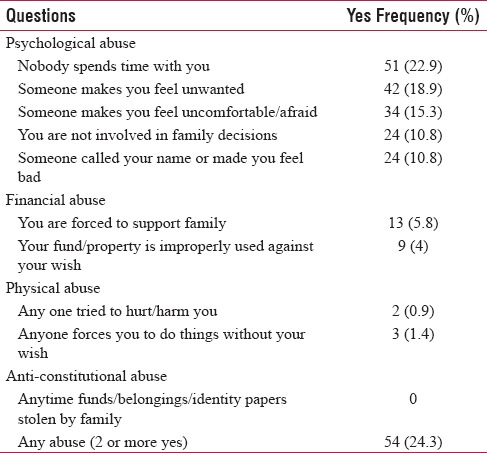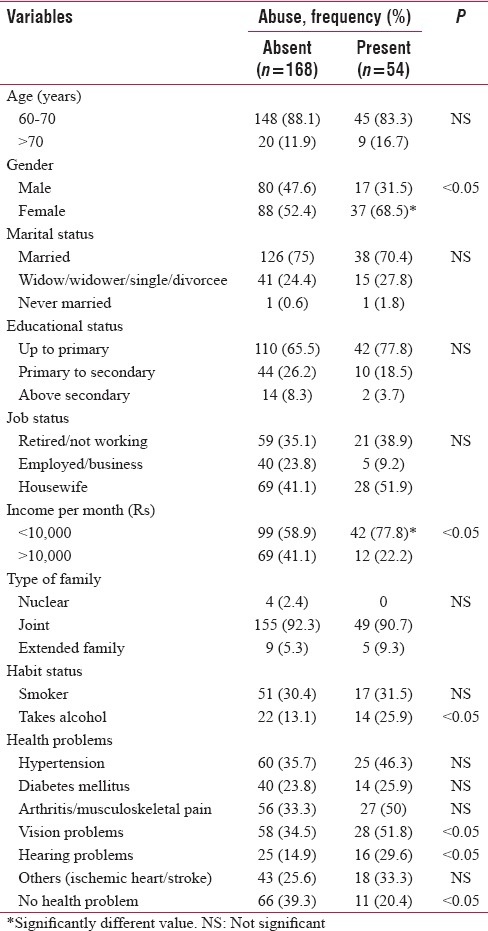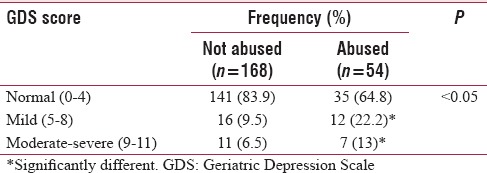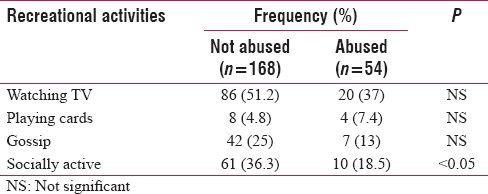Abstract
Context:
Elder abuse is a serious problem that has adverse consequence on health. Still, research on elder abuse is sparse in India.
Aims:
This study aimed to find the nature, prevalence, and factors such as depression and physical problems associated with elder abuse in an urban North Indian community.
Materials and Methods:
A cross-sectional study was conducted with 222 elders with 97 males, aged 60 years or older residing in an urban community of Delhi. Elders were assessed for abuse by modified Vulnerability to Abuse Screening Scale questionnaire, Geriatric Depression Scale, and self-reported questions on health problems.
Results:
Mean age of the study population was 66.3 ± 4.2 years. The overall prevalence of any type of elder abuse was 24.3%. Psychological abuse was the most common type (22.9%) followed by financial abuse (5.8%), physical abuse (1.4%), and anti-constitutional abuse (nil). Among the abused, nearly 20% experienced more than one type of abuse. Thirty-seven women (30%) and 17 men (18%) reported elder abuse. Low income (<Rs. 10,000/month), female gender, and visual and hearing problems were risk factors for elder abuse while socially active and good health were protective against abuse. Depression and alcohol consumption were associated with elder abuse.
Conclusion:
Elder abuse is common in urban North India and is underreported. Appropriate interventions are required to ameliorate the problem.
Keywords: Delhi, geriatric, maltreatment, mistreatment, neglect, Vulnerability to Abuse Screening Scale
INTRODUCTION
The number of elder people is growing steadily. As per the 2011 census, the elder population in India is 104 million as compared with 57 million in 1991 and is projected to rise to 324 million by 2050.[1] Nearly 8.6% of India's population is at or above 60 years (census 2011).[1] This rapid aging trend presents a new challenge to the society and the government.
Physiological changes that occur due to normal aging impair the ability to perform activities essential to live independently in the community. Elders are a special group because of physiological limitation, decreased motor power, mental abilities, and comorbid conditions. Furthermore, they have limited financial resources and limited social support. These changes in elders make them prone to be abused by their families and their close ones.
As per the World Health Organization, elder abuse is “a single or repeated act or lack of appropriate action, occurring within any relationship where there is an expectation of trust, which causes harm or distress to an older person.”[2] The prevalence of elder abuse varies across the globes from 2.6% to 14%.[3]
Abuse can be physical, psychological, financial, and anti-constitutional. Elder abuse is associated with significant adverse health outcomes.[4,5] Dong et al. reported that elder abuse is associated with increased morbidity and mortality.[6]
However, our understanding of elder abuse in India is limited because, traditionally, it has been thought that elder abuse is uncommon and Indians respect one's parents, elders, and ancestors. Elder abuse is hidden frequently cloaked under the shroud of family secrecy.
There is a dearth of community studies from India investigating elder abuse and its associated risk factors. Majority of studies on elder abuse in India are in institutional or hospital setting.
Depression and physical problems leading to decreased functional status may increase dependency that may contribute to elders' abuse.[7]
The objective of this study was to assess the prevalence of elder abuse and to identify association with depression and physical problems in an urban community of North India.
MATERIALS AND METHODS
This cross-sectional survey was conducted in 2014 in an urban community of South Delhi which is a resettlement colony of Delhi where people have migrated in search of work. Considering the study prevalence and risk factors of abuse among community-dwelling elderly of Guwahati[8] in which the abuse reported is 9.31%, therefore, assuming similar prevalence for our urban community population, sample size was calculated using the formula n = 4PQ/L2, where P was taken 10% and allowable error as 4% of P. The sample size calculated was 225. Probability proportionate sampling method was adopted for enrolling the participants. This urban community area was divided into four areas, and the list of houses with elderly present (912) was obtained from Asha worker. Proportion of number of houses in each area was considered to randomly select 60–80 houses from each area. They were approached individually in their homes; if not found on two visits, next random number house was considered. Consent obtained for participation and confidentiality was assured. Data collected through face-to-face interview in their homes.
Participants were cognitively intact above 60 years of age. Tool used for data collection was a structured interview schedule. Demographic characteristics included information pertaining to age, gender, education (primary and secondary), monthly income (rupees), marital status, and number of family members. Physical and health problems were assessed by a self-developed structured questionnaire. Health problems were confirmed on the basis of medical history, diagnosis, and treatment done earlier elsewhere. Depression was assessed by 15-item Geriatric Depression Scale,[9] and score above 5 was considered depression.
Vulnerability to Abuse Screening Scale developed by Schofield and Mishra[10] was modified according to the Indian setup to assess abuse. Psychological abuse domain had five questions, financial abuse domain had two questions, physical abuse domain had two questions, and anti-constitutional abuse domain had one question [Table 1]. Answering positive for any two questions from any domain was considered abuse.
Table 1.
Assessment of self-reported abuse (n=222)

Ethical approval for the study was obtained from the ethics committee. A pilot study was conducted for feasibility.
Statistical analysis
Descriptive statistics were calculated for all variables and presented as means and standard deviations for continuous variables and frequencies and percentages for categorical data. Univariate comparison between cases of abuse was performed using Pearson's Chi-squared test statistics. Two-sided P < 0.05 was considered statistically significant. All statistical analysis was performed using SPSS 24 (IBM© SPSS© statistics, IBM Corporation and its licensors 1989, 2016).
RESULTS
A total of 222 elderly were recruited and 97 were men (44%). The majority of participants (87%) were in the age range of 60–70 years. The participants' mean age was 66.3 ± 4.2 years. Most participants, i.e., 141 (64%) had income < Rs. 10,000 per month. The majority of elders lived in joint family 204 (92%). Average household size was 6.3. Majority had education up to primary.
The overall prevalence of elder abuse was 24.3% [Table 1]. Thirty-seven women (30%) and 17 men (18%) reported abuse [Table 1]. Psychological abuse was the most common form of abuse (22.9%) followed by financial abuse (5.8%) and physical abuse (1.4%). Very few (4%) reported abuse in three domains, i.e., psychological, financial, and physical abuse whereas 16% reported abuse in two domains, i.e., financial and psychological abuse.
Abused elderly group had significantly more number of females (68.5%), had income < 10,000/month (77.8%), had more alcohol drinkers (25.9%), and had more elders with vision problems (51.8%) and hearing problems (29.6%) compared to nonabused group. More elderly in nonabused group were healthy (31.3%) [Table 2].
Table 2.
Characteristics of elderly population as per their abuse status (n=222)

Depression was found among 46 (20.7%) elderly. Abused elderly group had more number of depressed elderly (35%) compared to nonabused group (P < 0.05) [Table 3].
Table 3.
Assessment of depression by Geriatric Depression Scale among elderly as per the abuse status

During their leisure time, the elders indulged in recreational activities. In this study, nearly 48% of the elders preferred to watch television and 22% spent time in gossips. About 32% preferred to spend time in social activities in the community. Other than social activity, recreation activities were similar in both nonabuse and abused elderlies. However, 85% socially active elders belong to nonabused group (P = 0.02) [Table 4].
Table 4.
Recreational activities of elderlies as per their abuse status (n=222)

DISCUSSION
Elder abuse is still a taboo and a hidden problem in India. Satisfying the need of elders for respect, care, and love contributes to their mental and physical health.
To our knowledge, this study represents the first study of elder abuse in an urban community of Delhi. Only a handful of studies have been done on elder abuse in North India.
This study revealed several important findings. Nearly one-fourth of elderlies were abused. Psychological abuse was the most frequent type of abuse reported. More women than men were victim of abuse in our study.
Our population demographic characteristics are similar to elderlies in any urban community of India. Demographic characteristic reported by HelpAge India is similar to our study except that almost 33% of their study population of Delhi were graduates or postgraduates in contrast with our study.[11]
Our findings reveal that 24.3% of elders experienced at least one type of abuse. Almost one-fifths of abused elders experienced more than one type of abuse. This is consistent with studies from other countries. A study from China reported that 35% elders living in urban area experienced abuse.[12] Similarly, over 18% of Israeli elders experienced abuse[13] and 14% of urban elders from Bangaldesh were at some point abused.[14] A study from Northeast India revealed the prevalence of elder abuse to be 9.3%, but they excluded elderlies with depression.[8] Our study found psychological abuse in 22.9%, financial abuse in 5.8%, and physical abuse in 1.4%. This is consistent with studies in Europe (6.9%–35.6% for psychological, 1.7%–9.6% for financial and 0.3%–2% for physical abuse)[15] and in the United States (9% for verbal, 3.4% for financial, and 0.2% for physical abuse).[16] Financial abuse at 5.8% is noteworthy because elders generally do not perceive providing financial support for their families as abusive even if it meant denying their own needs.
A study from Ludhiana in North India reported a higher prevalence of abuse of elders in urban community, psychological in 71%, financial in 37%, and physical in 14%, due to differences in the composition of the participant literacy status, economic status, and health status, respectively.[17] Another Indian study with significant educated participants showed emotional abuse in 62.5%, financial abuse in 12.5%, and physical abuse in 12.5%.[11]
On univariate analysis, female gender, low income, alcohol user, functional impairments, and depression were significantly associated with abuse of elders. However, being socially active and being healthy were negative predictors of abuse. Other studies[14] also ratify the findings that female gender and poverty are associated with elder abuse.
The prevalence of health problems in this study population was visual problems 38.7%, hypertension 38.2%, depression 20.7%, and hearing problems 18.5% and is similar to other studies in India.[18] It was comforting that even above 60 years, nearly 34.7% did not report any health problem. Nearly 85.7% of healthy elders did not face abusive behavior. Being healthy is protective for elder abuse because somatic health problems carry a high-risk dependency.[14,19]
Significantly more (52%) of abused elderlies had visual problems and 30% had hearing problems in comparison to nonabused elderlies. Chronic diseases such as diabetes, hypertension, and ischemic heart disease did not make elders prone to abuse, but elders with diminished vision and impaired hearing faced significantly more abuse because inability to effectively communicate weakens the bond.
The study showed the prevalence of depression to be 20.7% similar to 26% in a study by Seby et al.[20] Depression was positively associated with elder abuse, and the elders who faced abuse were two times more likely to be depressed than not facing abuse. However, it is difficult to say if depression poses a risk factor for elder abuse or elder abuse leads to depression. For this, prospective studies are needed. Our study stresses the importance of screening for elder abuse in people presenting with depression.
Significantly more (25.9%) elders who faced abuse consumed alcohol as compared to who did not face abuse (P = 0.03). Due to cross-sectional nature of study, it is difficult to decide the cause and effect relationship between elder abuse and alcohol consumption.
Those who are minimally active in community participation have a higher risk of being abused. As seen in our study, only 18% of abused were socially active whereas 36% of not abused were socially active (P = 0.02)
In contrast to other studies[14] where highly educated are protected from abuse, education level of elders in our study did not prevent abusive behavior against them. This is due to very few (<7%) were educated above higher secondary.
Very few studies have been conducted on the correlates of elder abuse in India. In one study the prevalence of abuse among older than 65 years was 14% and significant correlates of elder abuse were female gender, diminished social support and poor health.[21] Another study showed that reduced family size, double income, and higher life expectancy render the elders more susceptible to abuse.[22] On the other hand, social activity and healthy life were seen to be protective factors against elders abuse. Having friends and society provides a feeling of safety that decreases dependency on elders.[12,21] Social support acts as stress buffer by enhancing personal coping abilities such as self-esteem and self-efficacy and reduces the need of emotional support by family members.
The traditional norms and values of Indian society stress the importance of respecting, caring elders. However, industrialization, modernization, decreasing income per family, and dual career families have weakened the cohesiveness in families.
CONCLUSION
This study shows that abusive behavior against elders is common in urban North India but is underreported. Psychological abuse is most common. Low income, female gender, and functional impairment are risk factors for elder abuse while social activity and good health are protective against abuse. Depression and alcohol consumption are associated with abuse. Elders with depression and alcohol consumption should be screened for elder abuse.
Strategies such as self-care, socialization, sensitization of younger generation regarding care of elders, encouraging them to adhere to traditional cultural norms, are required.
Financial support and sponsorship
Nil.
Conflicts of interest
There are no conflicts of interest.
REFERENCES
- 1.Government of India. Elderly in India. [Last accessed on 2016 Feb 01]. Available from: http://www.mospi.nic.in/sites/default/files/publication reports/Elderly India 2016.pdf .
- 2.WHO. The Toronto Declaration on the Global Prevention of Elder Abuse. Geneva: WHO; 2002. [Last accessed on 2015 Jan 16]. Available from: http//www.ho.int/ageing/publications/Toronto-declaration/en/ [Google Scholar]
- 3.Daly JM, Merchant ML, Jogerst GJ. Elder abuse research: A systematic review. J Elder Abuse Negl. 2011;23:348–65. doi: 10.1080/08946566.2011.608048. [DOI] [PMC free article] [PubMed] [Google Scholar]
- 4.Dong X. Medical implications of elder abuse and neglect. Clin Geriatr Med. 2005;21:293–313. doi: 10.1016/j.cger.2004.10.006. [DOI] [PubMed] [Google Scholar]
- 5.Fisher BS, Regan SL. The extent and frequency of abuse in the lives of older women and their relationship with health outcomes. Gerontologist. 2006;46:200–9. doi: 10.1093/geront/46.2.200. [DOI] [PubMed] [Google Scholar]
- 6.Dong XQ, Simon MA, Beck TT, Farran C, McCann JJ, Mendes de Leon CF, et al. Elder abuse and mortality: The role of psychological and social wellbeing. Gerontology. 2011;57:549–58. doi: 10.1159/000321881. [DOI] [PMC free article] [PubMed] [Google Scholar]
- 7.Cooper C, Katona C, Finne-Soveri H, Topinková E, Carpenter GI, Livingston G, et al. Indicators of elder abuse: A crossnational comparison of psychiatric morbidity and other determinants in the ad-HOC study. Am J Geriatr Psychiatry. 2006;14:489–97. doi: 10.1097/01.JGP.0000192498.18316.b6. [DOI] [PubMed] [Google Scholar]
- 8.Saikia AM, Mahanta N, Mahanta A, Deka AJ, Kakati A. Prevalence and risk factors of abuse among community dwelling elderly of Guwahati city, Assam. Indian J Community Med. 2015;40:279–81. doi: 10.4103/0970-0218.164406. [DOI] [PMC free article] [PubMed] [Google Scholar]
- 9.Sheikh JI, Yesavage JA. Geriatric depression scale (GDS): Recent evidence and development of a shorter version. Clin Gerontol. 1986;5:165–73. [Google Scholar]
- 10.Schofield MJ, Mishra GD. Validity of self-report screening scale for elder abuse: Women's health Australia study. Gerontologist. 2003;43:110–20. doi: 10.1093/geront/43.1.110. [DOI] [PubMed] [Google Scholar]
- 11.Helpage India Report on elder abuse in India. 2010. [Last accessed on 2015 Oct 14]. Available from: https://www.helpageindia.org/images/pdf/ElderAbuseIndia10.pdf .
- 12.Dong X, Simon MA, Gorbien M. Elder abuse and neglect in an urban Chinese population. J Elder Abuse Negl. 2007;19:79–96. doi: 10.1300/J084v19n03_05. [DOI] [PubMed] [Google Scholar]
- 13.Lowenstein A, Eisikovits Z, Band-Winterstein T, Enosh G. Is elder abuse and neglect a social phenomenon? Data from the first national prevalence survey in Israel. J Elder Abuse Negl. 2009;21:253–77. doi: 10.1080/08946560902997629. [DOI] [PubMed] [Google Scholar]
- 14.Tareque MI, Ahmed MM, Tiedt AD, Hoque N. Can an active aging index (AAI) provide insight into reducing elder abuse? A case study in Rajshahi district, Bangladesh. Arch Gerontol Geriatr. 2014;58:399–407. doi: 10.1016/j.archger.2013.11.003. [DOI] [PubMed] [Google Scholar]
- 15.Lindert J, de Luna J, Torres-Gonzales F, Barros H, Ioannidi-Kopolou E, Melchiorre MG, et al. Abuse and neglect of older persons in seven cities in seven countries in Europe: A cross-sectional community study. Int J Public Health. 2013;58:121–32. doi: 10.1007/s00038-012-0388-3. [DOI] [PubMed] [Google Scholar]
- 16.Laumann EO, Leitsch SA, Waite LJ. Elder mistreatment in the United States: Prevalence estimates from a nationally representative study. J Gerontol B Psychol Sci Soc Sci. 2008;63:S248–54. doi: 10.1093/geronb/63.4.s248. [DOI] [PMC free article] [PubMed] [Google Scholar]
- 17.Kaur J, Kaur J, Sujata N. Comparative study on perceived abuse and social neglect among rural and urban geriatric population. Indian J Psychiatry. 2015;57:375–8. doi: 10.4103/0019-5545.171852. [DOI] [PMC free article] [PubMed] [Google Scholar]
- 18.Thakur R, Banerjee A, Nikumb V. Health problems among the elderly: A cross-sectional study. Ann Med Health Sci Res. 2013;3:19–25. doi: 10.4103/2141-9248.109466. [DOI] [PMC free article] [PubMed] [Google Scholar]
- 19.Moussavi S, Chatterji S, Verdes E, Tandon A, Patel V, Ustun B, et al. Depression, chronic diseases, and decrements in health: Results from the world health surveys. Lancet. 2007;370:851–8. doi: 10.1016/S0140-6736(07)61415-9. [DOI] [PubMed] [Google Scholar]
- 20.Seby K, Chaudhury S, Chakraborty R. Prevalence of psychiatric and physical morbidity in an urban geriatric population. Indian J Psychiatry. 2011;53:121–7. doi: 10.4103/0019-5545.82535. [DOI] [PMC free article] [PubMed] [Google Scholar]
- 21.Chokkanathan S, Lee AE. Elder mistreatment in urban India: A community based study. J Elder Abuse Negl. 2005;17:45–61. doi: 10.1300/j084v17n02_03. [DOI] [PubMed] [Google Scholar]
- 22.Jamuna D. Issues of elder care and elder abuse in the Indian context. J Aging Soc Policy. 2003;15:125–42. doi: 10.1300/J031v15n02_08. [DOI] [PubMed] [Google Scholar]


